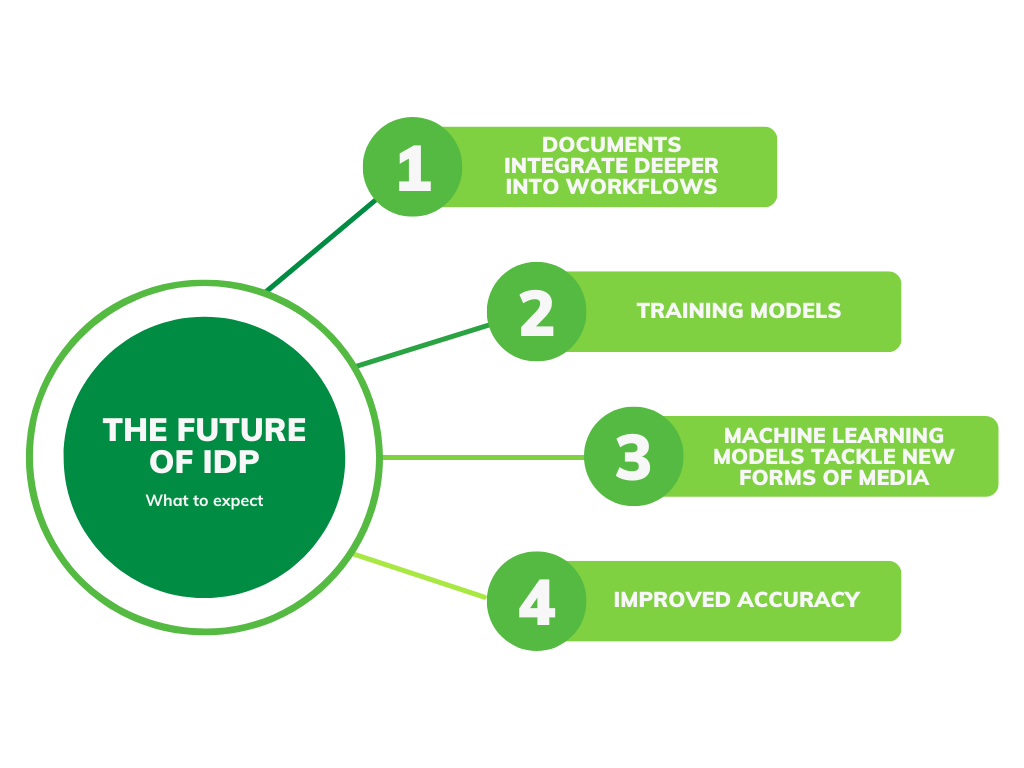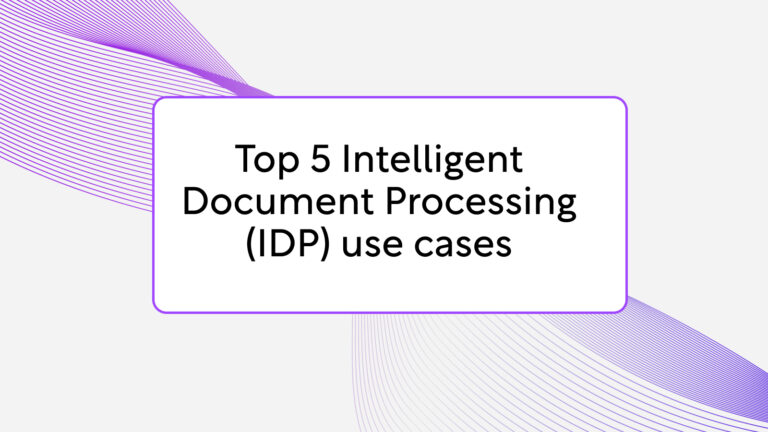How long does it take you to assess your organization’s data? Look at it this way: say you have 500 sheets of unprocessed documents sitting on your desk. That’s your standard ream of copy paper. With everything else crowding your to-do list, dealing with it creeps further and further onto the back burner. Left unchecked, the stack would grow to 43 feet in just two years—about the length of a yellow school bus.
That doesn’t begin to count the number of invoices, applications, contracts, and other documents stagnating on company shared drives, document management systems, and in forgotten desktop folders. It’s no surprise that apps and tools like Intelligent Document Processing (IDP) that make document processing faster, easier, and more cost-effective top the list of must-have tech. But as unstructured data continues to skyrocket, so do innovations in IDP.
In this article, we’ll discuss:
- How IDP rose to popularity
- The future trajectory of IDP
- New developments to expect in IDP
How intelligent document processing rose to popularity
Despite its recent celebrity status in the tech sector, the technologies that underpin intelligent document processing are not entirely new technologies. Over a hundred years ago, one inventor harnessed Optical Character Recognition (OCR) to convert handwritten notes into the dashes and dots used by telegraph operators.
Fast-forward a few generations, and iterations of the technology are everywhere: using your smartphone, Amazon can read the verification code off gift cards left by Santa, and cops can snatch license plates off videos of vehicles speeding away from a bank robbery. Right in your back office, OCR extracts numbers from invoices to populate accounting systems or drops serial numbers from warranty complaints into an inventory manager.
IDP thrives healthily across every industry. Organizations use niche software to process invoices and extract hallowed passages from yellowing books into historical archives. Larger behemoths seamlessly integrate intelligent document processing software into broader software offerings like hyperautomation and business process automation (BPA). With so many IDP use cases, there is a surplus of benefits of intelligent document processing. So where is IDP headed from here?
The future of intelligent document processing (IDP) solutions

The future of intelligent document processing is an exciting area of technology with endless possibilities. In the next few years, we can expect to see tremendous advancements in the way we interact with, analyze, and process large volumes of information contained in documents. Here are five trends guiding the future of IDP innovation.
1. Documents integrate deeper into workflows
IDP can parse needle-in-a-haystack details from incoming documents and insert them into a workflow. For example, a bank can rip personal identifiers like names and birthdates from a passport snap and insert the findings into OFAC or other sanctions lists that check for nefarious backgrounds.
The ultimate goal for any organization exploring automation should be process orchestration. Like it says in the name, you can think of process orchestration as the beautiful experience of a coordinated orchestra. Instead of a bunch of tasks raucously hammering away at disjointed notes, every task plays the right notes and in the right order, coalescing into blissful harmony.
From an IDP perspective, process orchestration will further blend data and documents into finely tuned workflows. Instead of just filing an application away or sending it up the rungs for approval, information folds into processes as a live data point. Contract dates, and company locations—even the excitement expressed in a customer testimonial—can become actionable intel that triggers workflow tasks.
2. Training models are the new gold standard
Scaling up your business and signing new customers all result in an explosion of incoming documents. With the increasing focus on digital transformation, there will be greater demand for tools that can process large volumes of documents efficiently and accurately.
This is a good thing for organizations leveraging IDP—the more information available, the better the training set. The influx of documents combined with human input will continue to hone the accuracy of machine-learning models. Access to large swaths of samples will become the new gold standard, a valuable asset that IDP vendors can use to attract new clients.
3. Machine learning models tackle new forms of media
Documents are all inherently paper-based, but as a society, we’re racking up unstructured data more than ever before. This type of data includes everything that doesn’t follow a rigid template: think the constraints of a checkerboard vs. an open-world video game.
The back-end technology evaluating both written and spoken language is called natural language processing (NLP). NLP is a subfield of artificial intelligence, that focuses on helping machines understand and process the quirks of human language. NLP can pick up on idioms, discern between adjectives and nouns, and pluck specific entities like a customer’s first name from a larger block of text. NLP ninjas are also honing their soft skills—the technology can skim a testimonial or Tweet and grade how positive or negative it leans.
With the rise of NLP, we can expect to see more sophisticated document processing tools that can understand the meaning of the text they are processing, rather than just the structure of the document. This will enable new applications such as automatic summarization, translation, and question-answering.
4. Improved accuracy
Large language models (like the media darling ChatGPT) are expanding computers’ situational awareness. Computers can now understand context: they’ll pen you a love letter or give you the eli5 low-down on quantum physics. It’s NLP on steroids—worth more than playful news stories of disappointed customers using LLM scripts to negotiate refunds.
LLMs will help IDP systems gain further context into the documents they ingest and can improve accuracy and enable new generative AI features like generating text or images. You might be able to ask it to write you a new sales contract based on clauses of your pre-existing agreements. Ask what contract terms were inadvertently omitted from a draft when a particular client agreement expires, or what customers share a particular SLA condition. In the future, you’ll be able to converse with your documents and unravel a fresh bounty of insights today’s search bars could never imagine.
The future of intelligent document processing is full of exciting possibilities and holds great potential for organizations looking to streamline their processes, reduce costs, and improve their ability to make informed decisions. Whether it’s through machine learning, NLP, or improved user experience, we can be sure that the next few years will see significant advancements in this area, making it easier and more efficient than ever to process and analyze large volumes of information contained in documents.
IDP revolutionizes the way we work with documents, leading organizations to achieve greater efficiency and accuracy with IDP’s automation capabilities. Embracing IDP can amplify decision-making with valuable insights. As the future of document processing, it’s time for organizations to explore the many benefits of IDP and embrace its transformative power. Our team stands ready to help organizations leverage IDP for smarter, more efficient work processes.





